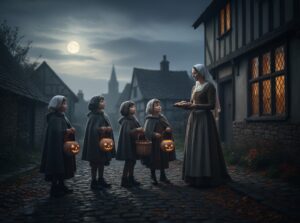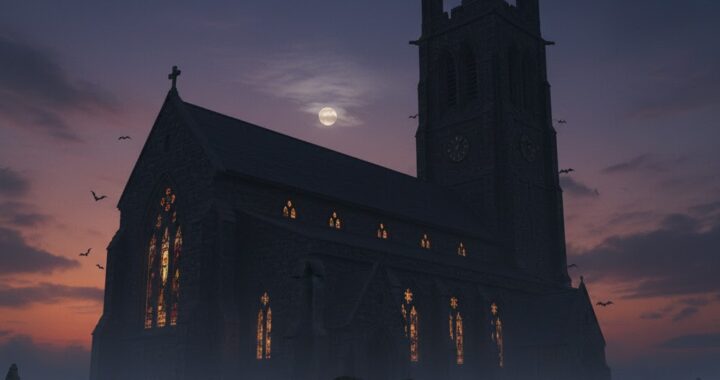Every October 31st, many Christians ask: “Is Halloween okay for believers?” The answer is yes—but it helps to understand why. The holiday we call Halloween actually has deep links to Christian tradition, especially to the feast of All Saints’ Day (November 1) and All Souls’ Day (November 2). By examining the Christian roots of Halloween and offering guidelines for celebrating appropriately, we can reclaim it as a faith-friendly occasion rather than one of fear or avoidance.
The Christian Origins of Halloween
The word Halloween comes from the traditional Catholic feast of “All Hallows Eve,” which commemorates the Solemnity of All Saints. The day after Halloween, All Saints Day, is a holy day of obligation. Here in the United States, the celebration of Halloween on October 31st includes trick-or-treating, jack-o’-lanterns, and other activities. For more information on Halloween, including its origins, see these various Catholic Answers resources.
From “All Hallows Eve” to Halloween
- The term “Halloween” comes from “All Hallows’ Eve” (the evening before All Saints’ Day).
- All Saints’ Day is a Christian feast that honours all the saints—those formally canonized and those who remain unknown.
- The vigil or evening before a major feast (like Christmas Eve or Easter Eve) has long been part of Christian liturgical tradition. The vigil for All Saints’ Day is the basis for what we now call Halloween.
Why November 1?
- In early medieval times, the Western Church moved the observance of All Saints’ Day to November 1, thereby giving the preceding evening significance as its vigil.
- The liturgical season known as All Hallowtide (or Hallowtide) spans October 31–November 2 and is explicitly about remembering the dead: martyrs, saints, and all the faithful departed. (Wikipedia)
Christ ian Practices Embedded in Halloween Traditions
ian Practices Embedded in Halloween Traditions
- One medieval Christian custom was “souling”—poor Christians would go door-to-door offering prayers for the dead in exchange for “soul cakes.” This practice links directly to the idea of All Hallowtide.
- Lighting candles on graves, visiting the cemetery, and remembering loved ones who have died—all find their place in the Christian observance of All Souls’ Day and its vigil.
- While there are pagan Celtic origins (Samhain) marking the end of harvest and a kind of “peer to the dead” motif, the Christian tradition repurposed the calendar and the memory-of-the-dead dimension into something centred on Christ, the saints, and the communion of believers past and present. (HISTORY)
Why It’s Appropriate for Christians to Celebrate
- It honours life, not just fear of death.
Because the vigil is tied to remembering saints and faithful departed, Halloween (or “All Hallows’ Eve”) can help Christians reflect on mortality, heaven, and our hope in Christ. - It offers an opportunity for witness.
Instead of simply rejecting October 31, Christians can use it to engage: host a safe, light-hearted event, invite neighbours, or share faith in a winsome way. - It reclaims cultural practices for good.
Many secular Halloween customs (costumes, community gatherings, treats) are not inherently evil. The key is the intention and the context. Celebrating with charity, hospitality, fun in the light of faith is quite different from embracing fear, occultism, or excess. - It keeps memory and hope together.
The Christian root reminds us that we honour those who have gone before, yet we live in hope of resurrection and eternal life. Halloween doesn’t have to be morbid—it can be a doorway to praise.
How to Celebrate Halloween Appropriately as a Christian
- Keep the Gospel front and centre. When you host or participate, maybe include a conversation about saints, heaven, or what it means to live as a believer in community.
- Offer hospitality. Invite friends or neighbours into your home, serve treats, and perhaps share a short blessing or reflection.
- Avoid glorifying darkness. Steer clear of themes that celebrate evil, the occult, or the demonic as “fun” without context. Instead, turn the focus toward light, renewal, and fellowship.
- Use symbolism wisely. A carved pumpkin or lantern can remind us that Christ is our light in darkness (cf. John 8:12). Candles on graves or markers can remind us to pray for the faithful departed.
- Remain discerning. Not all Halloween activities align with all Christian convictions—especially ones that cross into occult practices or unsafe behaviour. Where needed, choose alternatives (e.g., “Harvest Festival” or “Blessing of the Neighbours” event) that maintain community, celebration, and faith.
- Involve your faith community. A church might host a safe trick-or-treat evening, a costume parade with positive themes, a prayer for children, or a service of remembrance.
Addressing Common Concerns
- “But Halloween is pagan!”
Yes, some of the customs indeed stem from pagan festivals (Samhain). But the Christian church intentionally incorporated and transformed these into the Christian calendar. What matters is that Christians engage the occasion with faith, not fear. (Christianity.com) - “Isn’t it too spooky or evil themed?”
It can be. The difference lies in how you participate. If the dominant theme is fear-porn, horror-obsessed, or occultist, then caution is wise. But if you redirect the narrative—community, light, remembrance—you can use it well. - “Should we just skip it altogether?”
Some choose that, and it can be a valid personal conviction. Yet many others find value in redeeming the day. The key is unity in conscience (Romans 14), respect for others’ convictions, and a clear purpose.
Conclusion
Celebrating Halloween as a Christian need not be a contradiction—it can be a redeemed opportunity. The holiday’s lineage reaches back not only into the harvest fields of the Celts but more firmly into the Christian tradition of remembering saints, praying for the dead, and living in hope. As believers, we can enter October 31 with intentionality: offering joy, hospitality, light in the darkness, and a witness to the One who has conquered death. So this year, light a candle, open your door, welcome a neighbour, and say thank-you to the “great cloud of witnesses.”


Pingback: How Halloween Came to Be | Titanic News Channel